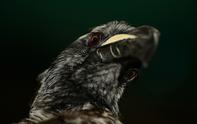
Name
African Grey Hornbill - Tockus nasutus
Appearance
The African grey hornbill is a medium-sized bird, but one of the smaller hornbills at 46 cm in length. This hornbill has mostly grey upperparts and the head, flight feathers and long tail are a darker shade of grey. The bill is dark, long and curved, with a small casque and a cream coloured stripe running along the bill. The face has a white line down the side of the head, with a white line visible in flight, on the back. The female has a red tip to the bill, with the upper mandible being pale yellow in colour.
This hornbill is distinguished from other hornbills by its dark bill, with a cream stripe and the white eye stripe.
African Grey Hornbill Diet
The African grey hornbill feeds mostly on insects, but will feed on seeds. They feed mainly in trees.
African Grey Hornbill Breeding
The African grey hornbill nests in natural tree cavities. The female will seal herself inside the cavity, using a mixture of mud and her own dung. To facilitate feeding, she will leave a small hole so the male can feed her and the chicks.
The female incubates her two to four eggs for around 24 days and remains in the nest with the chicks until the nest becomes too small. At this point, the female will let herself out and reseal the nest with the chicks inside. The feeding of the chicks is done by both parents. At around 45 days from hatching, the chicks will break out of the nest and start foraging with the parents a couple of days later.
Threats
None.
African Grey Hornbill Distribution and Habitat
The African grey hornbill is common in miombo forests. This hornbill is found across the northern parts of South Africa and in the Kruger Park area.